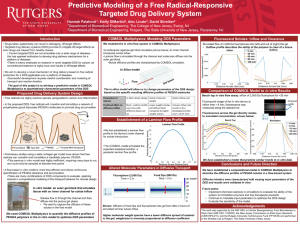Palahnuk, Hannah: Predictive Modeling of a Free Radical-Responsive Targeted Drug Delivery System
Title: Predictive Modeling of a Free Radical-Responsive Targeted Drug Delivery System
Name: Hannah Palahnuk
Home Institute: The College of New Jersey
Programs: RISE program, REU – Cellular Bioengineering
Other contributors: Emily DiMartini, Alec Licato
Abstract: Drugs administered systemically can cause damaging side effects. Targeted drug delivery systems (DDS) deliver drugs locally to diseased tissues and mitigate off-target effects. Many current targeted DDS work through disease-specific molecules, such as ligand-receptor pairs.
These systems are not amenable to more than one pathology due to molecular individuality per disease. An alternative to this highly specific approach is targeting a pathological characteristic common to many diseases. For example, an increased concentration of free radicals in diseased tissues is a common denominator among many cancer types. The long-term goal of this research is to develop a DDS that targets free radical production over a platform of diseases. In the proposed DDS, free radicals will crosslink polyethylene glycol diacrylate (PEGDA) polymers into an immobilized network to trap and accumulate therapeutic at diseased sites. Preliminary studies show that physiological free radicals can crosslink PEGDA, but the in vitro model used was highly inefficient and only allowed discrete sampling. We have implemented a flow-based in vitro model allowing continuous evaluation of PEGDA accumulation. In further DDS design, there remain many combinations of components, such as polymer size and concentration, that can be efficiently evaluated through computational modeling. In this REU, we established a computational model of the flow-based system in COMSOL Multiphysics to quantify the diffusive profiles of PEGDA polymers. The in-silico device geometry is a hollow cylinder along the long axis of a porous, rectangular prism. Laminar Flow and Transport of Diluted Species in Porous Media physics interfaces were employed in COMSOL in the channel and prism, respectively. This simulated solute inflow in the channel followed by diffusion into the gel. Solute size, concentration, and gel porosity were modulated to characterize diffusive profiles in the DDS. Preliminary results are promising and indicate computational data match in vitro trends. Moving forward, researchers will include free radicals in COMSOL to evaluate polymer immobilization.
Biography: Hannah Palahnuk is a rising senior studying biomedical engineering at The College of New Jersey (TCNJ). Hannah is the president of TCNJ’s Biomedical Engineering Society student-chapter and she participates in many on-campus leadership activities. Hannah conducted research in Drug Product Development at Celgene Corporation in Summer, 2019. She studied materials science and engineering and its technical applications to medicine. This Summer, Hannah joined Dr. Shreiber’s lab with the Cellular Bioengineering REU. Hannah is also working with a graduate student, Emily DiMartini. Her REU project aims to establish a computational model to optimize parameters of a novel targeted drug delivery system. Hannah plans to attend graduate school in Fall, 2021 studying biomedical engineering.
